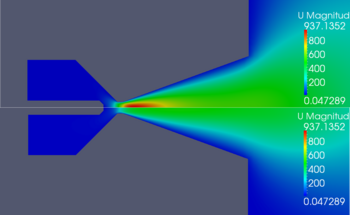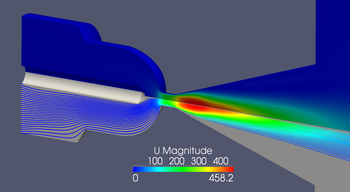Juan Gomez
Total fuel mass is one of the main economical and technical restrictions while designing space propulsion systems. Given the high costs related to the transport of mass into space, the total fuel mass necessary for accomplishment of the mission should be minimized. An optimum “thrust/fuel consumption ratio” demands the maximization of the gas exit velocity for a given mass flow. This can be achieved through the increase of propellant temperature and pressure in the propulsion system, which results in higher values for the speed of sound at the “throat” of the de Laval nozzle. In the project PlasmAccelerator arcjet propulsion systems are investigated. Higher gas exit velocities are achieved through the heating of a micro gas flow by an electric arc inside the sub-sonic region of the propulsion system. The electrical arc induces a partial ionization of the propellant gas, thus creating a plasma flow through the nozzle. The behavior of electric arc and propellant gas is modeled by custom solvers based on the open source CFD software package OpenFOAM. The numerical results are validated via a comparison with data from experimental rigs at ZARM. The project PlasmAccelerator aims at the development and validation of numerical models for the electric arc and the partial ionized gas inside an arcjet propulsion system. The project also focuses on the optimization of the arcjet propulsion system at ZARM based on the numerical results.




 "
"